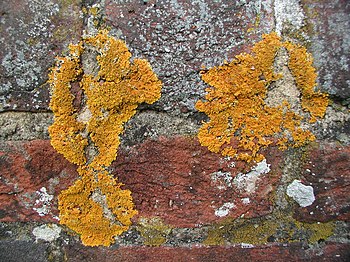
Back ক্রাসটোজ লাইকেন Bengali/Bangla Kooriksamblikud Estonian Lichen crustacé French Hrúðurflétta Icelandic Skorpelav NB


Crustose lichens are lichens that form a crust which strongly adheres to the substrate (soil, rock, tree bark, etc.), making separation from the substrate impossible without destruction.[1] The basic structure of crustose lichens consists of a cortex layer, an algal layer, and a medulla. The upper cortex layer is differentiated and is usually pigmented. The algal layer lies beneath the cortex. The medulla fastens the lichen to the substrate and is made up of fungal hyphae.[2] The surface of crustose lichens is characterized by branching cracks that periodically close in response to climatic variations such as alternate wetting and drying regimes.[3]
- ^ Büdel, B.; Scheidegger, C. (1996). "Thallus morphology and anatomy". In Nash, T. (ed.). Lichen biology. Cambridge: Cambridge University Press. pp. 37–41.
- ^ Laursen, G.; Seppelt, R. (2010). Common interior Alaska cryptograms: Fungi, lichenicolous fungi, lichenized fungi, slime molds, mosses, and liverworts (2nd ed.). Fairbanks, Alaska: University of Alaska Press. pp. 122–124.
- ^ Hawksworth, D.; Hill, D. (1984). The lichen-forming fungi. Glasgow: Blackie. pp. 16–22.